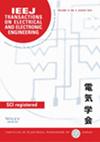下载PDF
{"title":"Cell-Based Transistors Detecting Cell Membrane Proteins for Liquid Biopsy","authors":"Miyuki Tabata, Yuji Miyahara","doi":"10.1002/tee.70124","DOIUrl":null,"url":null,"abstract":"<p>Liquid biopsy has caught the attention of medical doctors for diagnosing or managing diseases through less invasive testing of body fluids. In liquid biopsy, there are various markers used to detect cancer, such as small nucleic acids and circulating tumor cells (CTCs), along with extracellular vesicles (EVs). Detecting CTCs in patients' blood is crucial, as it provides important information about proteins and sugar chains on their membranes and the nucleic acids inside. However, detecting CTCs is difficult because they are rare compared to the millions of blood cells present. To address this challenge, we propose a new method using ion-sensitive field-effect transistors (ISFETs) combined with chemical signal amplification through enzyme reactions to detect cell membrane proteins. We tested this method using breast cancer cell lines as models for CTCs and successfully detected human epidermal growth factor receptors (HER2 and EGFR) on their membranes using cell-based transistors. Initially, we demonstrated the detection of HER2 through an enzyme reaction using the BT474 breast cancer cell line. Then, we compared EGFR expression among four types of breast cancer cell lines using the cell-based transistors, and the results were consistent with fluorescence detection using fluorescence-activated cell sorting (FACS). These cell-based transistors offer advantages in terms of miniaturization and analyzing target molecules on cell and EV membranes in parallel. Their small size and cost-effectiveness for cancer testing could make them a reality in future liquid biopsy methods. In this review, we present our recent advancements in cell-based transistors. We will then explore the future prospects of cell-based transistors in liquid biopsy. © 2025 Institute of Electrical Engineers of Japan and Wiley Periodicals LLC.</p>","PeriodicalId":13435,"journal":{"name":"IEEJ Transactions on Electrical and Electronic Engineering","volume":"20 10","pages":"1526-1533"},"PeriodicalIF":1.1000,"publicationDate":"2025-08-17","publicationTypes":"Journal Article","fieldsOfStudy":null,"isOpenAccess":false,"openAccessPdf":"https://onlinelibrary.wiley.com/doi/epdf/10.1002/tee.70124","citationCount":"0","resultStr":null,"platform":"Semanticscholar","paperid":null,"PeriodicalName":"IEEJ Transactions on Electrical and Electronic Engineering","FirstCategoryId":"5","ListUrlMain":"https://onlinelibrary.wiley.com/doi/10.1002/tee.70124","RegionNum":4,"RegionCategory":"工程技术","ArticlePicture":[],"TitleCN":null,"AbstractTextCN":null,"PMCID":null,"EPubDate":"","PubModel":"","JCR":"Q4","JCRName":"ENGINEERING, ELECTRICAL & ELECTRONIC","Score":null,"Total":0}
引用次数: 0
引用
批量引用
Abstract
Liquid biopsy has caught the attention of medical doctors for diagnosing or managing diseases through less invasive testing of body fluids. In liquid biopsy, there are various markers used to detect cancer, such as small nucleic acids and circulating tumor cells (CTCs), along with extracellular vesicles (EVs). Detecting CTCs in patients' blood is crucial, as it provides important information about proteins and sugar chains on their membranes and the nucleic acids inside. However, detecting CTCs is difficult because they are rare compared to the millions of blood cells present. To address this challenge, we propose a new method using ion-sensitive field-effect transistors (ISFETs) combined with chemical signal amplification through enzyme reactions to detect cell membrane proteins. We tested this method using breast cancer cell lines as models for CTCs and successfully detected human epidermal growth factor receptors (HER2 and EGFR) on their membranes using cell-based transistors. Initially, we demonstrated the detection of HER2 through an enzyme reaction using the BT474 breast cancer cell line. Then, we compared EGFR expression among four types of breast cancer cell lines using the cell-based transistors, and the results were consistent with fluorescence detection using fluorescence-activated cell sorting (FACS). These cell-based transistors offer advantages in terms of miniaturization and analyzing target molecules on cell and EV membranes in parallel. Their small size and cost-effectiveness for cancer testing could make them a reality in future liquid biopsy methods. In this review, we present our recent advancements in cell-based transistors. We will then explore the future prospects of cell-based transistors in liquid biopsy. © 2025 Institute of Electrical Engineers of Japan and Wiley Periodicals LLC.
基于细胞的晶体管检测细胞膜蛋白用于液体活检
液体活检通过对体液进行侵入性较小的检测来诊断或治疗疾病,引起了医生的注意。在液体活检中,有各种用于检测癌症的标志物,如小核酸和循环肿瘤细胞(ctc),以及细胞外囊泡(ev)。检测患者血液中的ctc至关重要,因为它提供了关于膜上的蛋白质和糖链以及内部核酸的重要信息。然而,检测ctc是困难的,因为与存在的数百万血细胞相比,它们是罕见的。为了解决这一挑战,我们提出了一种利用离子敏感场效应晶体管(isfet)结合酶反应的化学信号扩增来检测细胞膜蛋白的新方法。我们使用乳腺癌细胞系作为ctc模型测试了这种方法,并成功地使用基于细胞的晶体管检测了其膜上的人表皮生长因子受体(HER2和EGFR)。最初,我们使用BT474乳腺癌细胞系通过酶反应证明了HER2的检测。然后,我们使用基于细胞的晶体管比较了四种乳腺癌细胞系中EGFR的表达,结果与荧光激活细胞分选(FACS)的荧光检测结果一致。这些基于电池的晶体管在小型化和并行分析电池和EV膜上的目标分子方面具有优势。它们的体积小,成本效益高,这可能使它们成为未来液体活检方法的现实。在这篇综述中,我们介绍了基于细胞的晶体管的最新进展。然后,我们将探讨基于细胞的晶体管在液体活检中的未来前景。©2025日本电气工程师协会和Wiley期刊有限责任公司。
本文章由计算机程序翻译,如有差异,请以英文原文为准。


 求助内容:
求助内容: 应助结果提醒方式:
应助结果提醒方式:


